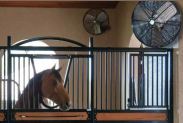 If you are lucky enough to be getting a tax return from the government this year, consider investing at least some of that money into upgrading your barn. As we’ve said before, you don’t have to do a major overhaul all at one time to get your dream barn. Start with something small that can make a big impact on your barn’s look and/or functionality.
If you are lucky enough to be getting a tax return from the government this year, consider investing at least some of that money into upgrading your barn. As we’ve said before, you don’t have to do a major overhaul all at one time to get your dream barn. Start with something small that can make a big impact on your barn’s look and/or functionality.
Some great things to invest in could include:
More ventilation – with warmer days coming up soon, now’s the good time to see about  replacing your old box fans with new barn-safe fans. Most box fans motors are not sealed. This creates a fire hazard should they become dusty and overheat. Some electrical products to be sure they are meant for the rigors of a barn environment! Barn-appropriate fans are usually either basket type or ceiling type.
replacing your old box fans with new barn-safe fans. Most box fans motors are not sealed. This creates a fire hazard should they become dusty and overheat. Some electrical products to be sure they are meant for the rigors of a barn environment! Barn-appropriate fans are usually either basket type or ceiling type.
 More light – even though days are getting longer, barn interiors can still remain dark. Add barn lights. Horses often have a time adjusting their eyesight from light to dark areas and can spook or even resist when moving in and out of light. Lights in the barn can help alleviate that problem. Also consider lights around entryways to the barn for safety reasons.
More light – even though days are getting longer, barn interiors can still remain dark. Add barn lights. Horses often have a time adjusting their eyesight from light to dark areas and can spook or even resist when moving in and out of light. Lights in the barn can help alleviate that problem. Also consider lights around entryways to the barn for safety reasons.
More support – while horse tend to have more turnout and exercise time during the summer, they still appreciate the comfort of having a stall mat to stand on in their stall. Plus, it makes stall cleaning easier and more cost-effective for you by using less shavings.
 Easier bathing – summer often means more bath time for your horse, whether for an upcoming show or just to hose the sweat off after a long ride. But if you are tired of being tangled up in hoses or having your horse mistake one for a snake, consider investing in an over-the top washer. This wash unit keeps the hose above the animal’s head and off the floor. The hose holder keeps the hose above the horse’s head, making it easy to move quietly and quickly.
Easier bathing – summer often means more bath time for your horse, whether for an upcoming show or just to hose the sweat off after a long ride. But if you are tired of being tangled up in hoses or having your horse mistake one for a snake, consider investing in an over-the top washer. This wash unit keeps the hose above the animal’s head and off the floor. The hose holder keeps the hose above the horse’s head, making it easy to move quietly and quickly.

More organization – an organized tack room is every barn’s dream. And now it can come true with the Ultimate Tack System. The Ultimate Tack System can handle all types of tack from the lightest English saddles to the heaviest Western rigs. Best of all, the Ultimate Tack System allows you to order any combination of components, so you can organize your tack, your way.
 If you need more ideas on how to spend your tax return to upgrade your barn, feel free to contact us.
If you need more ideas on how to spend your tax return to upgrade your barn, feel free to contact us.
 With the weather turning better, it seems the perfect time for a trail ride. But sometimes it’s hard to get everyone to the barn at the same time for the ride. At some point, almost any rider will have to ride alone. Riding alone can be a wonderful way to connect with your horse and enjoy some solitude, but there’s also an element of danger to mounting up when you’re the only one on the property. Before you ride solo, think about putting some or all of these safety tips to use.
With the weather turning better, it seems the perfect time for a trail ride. But sometimes it’s hard to get everyone to the barn at the same time for the ride. At some point, almost any rider will have to ride alone. Riding alone can be a wonderful way to connect with your horse and enjoy some solitude, but there’s also an element of danger to mounting up when you’re the only one on the property. Before you ride solo, think about putting some or all of these safety tips to use. It may be hard to believe in some parts of the country, but blanketing season is just about over! Quality horse blankets can be expensive, so it’s important to make them last as long as possible. Before you put them away for the year, here are some great tips to help prolong the life of your horse blankets.
It may be hard to believe in some parts of the country, but blanketing season is just about over! Quality horse blankets can be expensive, so it’s important to make them last as long as possible. Before you put them away for the year, here are some great tips to help prolong the life of your horse blankets. Before you know it, foaling season will be here. If you have broodmares in your barn, then it’s time to get ready for foaling season. Here’s a to-do list to make sure that you’re prepared for the busy season.
Before you know it, foaling season will be here. If you have broodmares in your barn, then it’s time to get ready for foaling season. Here’s a to-do list to make sure that you’re prepared for the busy season. Have you ever thought about taking a trip to Lexington, Kentucky? April and May are the perfect times of year to not only enjoy “The Horse Capital of the World,” but there are some major events to enjoy during that time. Late April is the
Have you ever thought about taking a trip to Lexington, Kentucky? April and May are the perfect times of year to not only enjoy “The Horse Capital of the World,” but there are some major events to enjoy during that time. Late April is the There are many “alternative” treatments for your horse – chiropractor, acupuncture, massage to name a few. Most of these require special training to do them correctly. But with some basic education, aromatherapy can be used by anyone for a variety of ailments.
There are many “alternative” treatments for your horse – chiropractor, acupuncture, massage to name a few. Most of these require special training to do them correctly. But with some basic education, aromatherapy can be used by anyone for a variety of ailments.  A while back, we wrote a blog about
A while back, we wrote a blog about  to eventually take in boarders for additional income in two years. Her two horses were very compatible and did not have to be kept separate. Initially she built a six stall barn – with one designated for each horse. With no stall fronts or dividers, her barn was initially a large run-in shed for her horses, separated when needed, by
to eventually take in boarders for additional income in two years. Her two horses were very compatible and did not have to be kept separate. Initially she built a six stall barn – with one designated for each horse. With no stall fronts or dividers, her barn was initially a large run-in shed for her horses, separated when needed, by  Mounted archery dates back thousands of years, and is one of the earliest forms of warfare. Horses gave humans speed and additional height. By learning to shoot a bow from horseback, riders gained an advantage over anyone on foot. Mounted archery also served as an effective hunting practice, allowing riders to see and bring down large, swift game.
Mounted archery dates back thousands of years, and is one of the earliest forms of warfare. Horses gave humans speed and additional height. By learning to shoot a bow from horseback, riders gained an advantage over anyone on foot. Mounted archery also served as an effective hunting practice, allowing riders to see and bring down large, swift game.